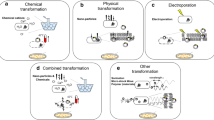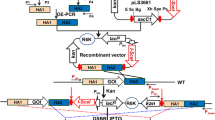Abstract
Objective
To improve the transformation efficiency of Corynebacterium glutamicum cells with heterogenous plasmid DNA and single-strand DNA (ssDNA) using a methodology based on electro-transformation.
Results
A semicomplex hypertonic medium was selected with addition of glycine and dl-threonine to weaken cell walls and addition of Tween 80 and isonicotinic acid hydrazide to increase cytoplasmic membrane fluidity. Their contents were optimized by response surface methodology. Cell growth, electro-transformation buffer, and transformation protocol were also optimized. Temporary heating inactivation of the host restriction enzyme showed a significant effect. Finally, a high transformation efficiency of 3.57 ± 0.13 × 107 cfu/μg DNA of plasmid and 1.05 × 106 StrR cfu per 109 viable cells with a ssDNA was achieved.
Conclusion
The results shed light on the application in functional genomics and genome editing of C. glutamicum.




Similar content being viewed by others
References
Davidson LA, Takayama K (1979) Isoniazid inhibition of the synthesis of monounsaturated long-chain fatty acids in Mycobacterium tuberculosis H37Ra. Antimicrob Agents Chemother 16:104
Esvelt KM, Wang HH (2013) Genome-scale engineering for systems and synthetic biology. Mol Syst Biol. doi:10.1038/msb.2012.66
Hammes W, Schleifer K, Kandler O (1973) Mode of action of glycine on the biosynthesis of peptidoglycan. J Bacteriol 116:1029–1053
Katsumata R, Ozaki A, Oka T, Furuya A (1984) Protoplast transformation of glutamate-producing bacteria with plasmid DNA. J Bacteriol 159:306–311
Kortmann M, Kuhl V, Klaffl S, Bott M (2014) A chromosomally encoded T7 RNA polymerase-dependent gene expression system for Corynebacterium glutamicum: construction and comparative evaluation at the single-cell level. Microb Biotechnol 8:253–265
Krylov AA, Kolontaevsky EE, Mashko SV (2014) Oligonucleotide recombination in corynebacteria without the expression of exogenous recombinases. J Microbiol Methods 105:109–115
Liebl W, Bayerl A, Schein B, Stillner U, Schleifer K (1989) High efficiency electroporation of intact Corynebacterium glutamicum cells. FEMS Microbiol Lett 65:299–303
Pátek M, Holátko J, Busche T, Kalinowski J, Nešvera J (2013) Corynebacterium glutamicum promoters: a practical approach. Microb Biotechnol 6:103–117
Sawitzke JA, Costantino N, Li X, Thomason LC, Bubunenko M, Court C, Court DL (2011) Probing cellular processes with oligo-mediated recombination and using the knowledge gained to optimize recombineering. J Mol Biol 407:45–59
Tan Y, Xu D, Li Y, Wang X (2012) Construction of a novel sacB-based system for marker-free gene deletion in Corynebacterium glutamicum. Plasmid 67:44–52
Van der Rest M, Lange C, Molenaar D (1999) A heat shock following electroporation induces highly efficient transformation of Corynebacterium glutamicum with xenogeneic plasmid DNA. Appl Microbiol Biotechnol 52:541–545
Van Kessel JC, Hatfull GF (2008) Efficient point mutagenesis in mycobacteria using single-stranded DNA recombineering: characterization of antimycobacterial drug targets. Mol Microbiol 67:1094–1107
Wang Y, Weng J, Waseem R, Yin X, Zhang R, Shen Q (2012) Bacillus subtilis genome editing using ssDNA with short homology regions. Nucleic Acids Res. doi:10.1093/nar/gks248
Xu D, Tan Y, Shi F, Wang X (2010) An improved shuttle vector constructed for metabolic engineering research in Corynebacterium glutamicum. Plasmid 64:85–91
Xu G, Jin X, Guo W, Dou W, Zhang X, Xu Z (2014) Characterization, modification, and overexpression of 3-phosphoglycerate dehydrogenase in Corynebacterium glutamicum for enhancing l-serine production. Ann Microbiol 65:929–935
Yu B, Shen W, Zhu G (2005) An improved method for integrative electrotransformation of Corynebacterium glutamicum with xenogeneic DNA. Appl Microbiol Biotechnol 25:78–81
Zhang G, Bao P, Zhang Y, Deng A, Chen N, Wen T (2011) Enhancing electro-transformation competency of recalcitrant Bacillus amyloliquefaciens by combining cell-wall weakening and cell-membrane fluidity disturbing. Anal Biochem 409:130–137
Acknowledgments
This work was supported by the Fundamental Research Funds for the Central Universities (JUSRP51306A & JUDCF13008 & JUSRP51402A), the Priority Academic Program Development of Jiangsu Higher Education Institutions, and Program of Introducing Talents of Discipline to Universities (No. 111-2-06).
Supplementary data
Supplementary Table 1—CCD matrix of four variables in coded units and the experimental and predicted values of transformation efficiency.
Supplementary Table 2—ssDNA sequence with different length targeted to modify rpsL gene.
Supplementary Table 3—Significance of the regression coefficients for the response surface model.
Supplementary Fig. 1—Mathematical model of the transformation efficiency predicted by response surface methodology.
Supplementary Fig. 2—Three-dimensional response surface and contour plots of the interactive effect between every two factors of Gly, dl-Thr, Gly and Tween 80 on the ETE of C. glutamicum. Actual factors of (A–F) are set at 0 in coded levels, respectively.
Author information
Authors and Affiliations
Corresponding author
Electronic supplementary material
Below is the link to the electronic supplementary material.
Rights and permissions
About this article
Cite this article
Ruan, Y., Zhu, L. & Li, Q. Improving the electro-transformation efficiency of Corynebacterium glutamicum by weakening its cell wall and increasing the cytoplasmic membrane fluidity. Biotechnol Lett 37, 2445–2452 (2015). https://doi.org/10.1007/s10529-015-1934-x
Received:
Accepted:
Published:
Issue Date:
DOI: https://doi.org/10.1007/s10529-015-1934-x




